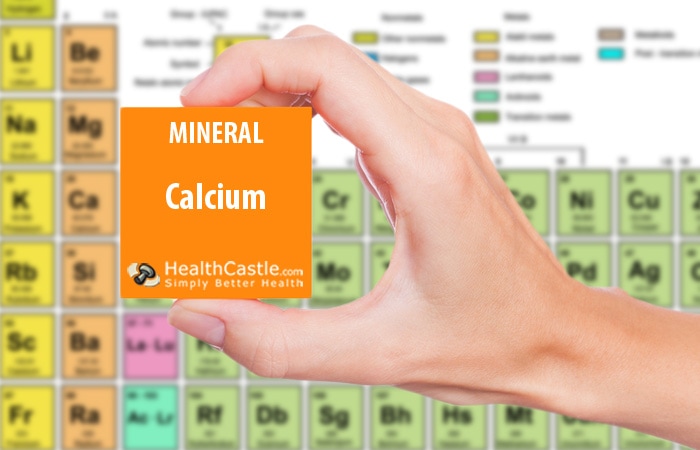
Written By: Sofia Layarda, MPH
Title: Master of Public Health
Alumni: University of California, Berkeley
Last Updated on:

Calcium is an essential mineral, required by our bodies at all ages, not just during growth years. The two most common supplement forms of calcium are calcium carbonate and calcium citrate.
Table of Contents
The Dietary Reference Intakes (DRI) for calcium are shown below:
| Age Group | Recommended Dietary Allowance (RDA) per Day1 | Tolerable Upper Intake Level (UL) per Day2 |
| Adults | ||
| 19 to 50 years | 1,000 mg | 2,500 mg |
| 51 to 70 years | 1,200 mg female; 1,000 mg male | 2,000 mg |
| 71 years and up | 1,200 mg | 2,000 mg |
| Kids and Youth | ||
| 1 to 3 years | 700 mg | 2,500 mg |
| 4 to 8 years | 1,000 mg | 2,500 mg |
| 9 to 18 years | 1,300 mg | 3,000 mg |
| Special Considerations | ||
|
Pregnant or lactating women 14 to 18 years |
1,300 mg |
3,000 mg |
| Pregnant or lactating women 19 to 50 years | 1,000 mg | 2,500 mg |
Note: For very young children, the reference levels provided are adequate intake (AI): 200 mg/day for infants up to 6 months old, and 260 mg for infants between 7 to 12 months old. There is no actual recommended dietary intake for these age groups.

Calcium is the most abundant mineral in the body. Ninety-nine percent of it is stored within our bones and teeth, with 1% circulating as serum calcium in the blood. The metabolism of calcium in the body is very tightly regulated, and the body uses the bones and teeth as both the source and the reserve of calcium to maintain serum calcium levels. Calcium is important in the maintenance of healthy bones and teeth3, as many of us know, but it is also involved in ensuring proper muscle function4, nerve transmission, cellular signaling, vascular contraction and dilation, and hormone secretion5. Calcium is also needed for blood to clot6.
Here are some of the richest calcium sources in the diet:
| Food | Calcium per serving |
| Plain yogurt, 6 oz | ~ 300 mg |
| Fruit-flavored yogurt, 6 oz | ~ 200 to 250 mg |
| Sardines, Atlantic, 3 oz | 351 mg |
| Mozzarella cheese, 1.5 oz | 333 mg |
| Sardines, 3 oz | 325 mg |
| Cheddar cheese, 1.5 oz | 307 mg |
| Milk, nonfat, 1 cup | 299 mg |
| Milk, reduced fat, 1 cup | 293 mg |
| Milk, whole, 1 cup | 276 mg |
| Non-dairy milk alternatives (e.g., rice, soy, nut), calcium fortified, 1 cup | 200 to 300 mg depending on manufacturer |
| Collard greens, chopped, cooked, 1 cup | 268 mg |
| Sesame seeds, 3 tbs | 264 mg |
| Tofu, firm, 1/2 cup (made with calcium sulfate)* | 253 mg |
| Sardine, Pacific, canned with bones, 3 oz | 214 mg |
| Spinach, frozen (chopped or leaf), 1 cup | 201 mg |
| Salmon, sockeye, canned 3 oz | 197 mg |
| Mustard greens, boiled, drained, 1 cup | 165 mg |
*Two common coagulating agents used to prepare tofu are magnesium chloride (nigari) and calcium sulfate. Tofu made with calcium sulfate will contain more calcium than nigari-style tofu.
Calcium is better absorbed under acidic conditions. Stomach acid production increases in the presence of food. Therefore, if you choose to take calcium supplements, it is best to take the supplement with a meal. There is a difference: calcium citrate – such as in Citracal and Solgar – is the “acidic” form and can therefore be taken on an empty stomach, whereas calcium carbonate – such as in Tums and Caltrate – is the “alkaline” form, which should be taken with a meal. In either case, taking the supplement with food will ensure you are optimizing the absorption of calcium. The efficiency of absorption decreases as calcium intake increases, so it is best to break up the doses throughout the day (no more than 500 mg at once).
In the US: The daily value for calcium is 1,300 mg7, which is the same level as the DRI for adults age 19-50. The % daily value gives you an idea of how much calcium is in the food you eat. The number you see on the Nutrition Facts label is a percentage calculated by dividing the amount of calcium in one serving of the food by the daily value. So, for example, a cup of calcium-fortified soy milk containing 200 mg calcium per serving would have 15% of the daily value (DV) for calcium. Foods containing 20% or more of the DV is considered to provide a high level of calcium.
In Canada: The daily value for calcium is 1,300 mg8, which is slightly higher than the DRI level for adults. Using the same example, the cup of calcium-fortified soy milk containing 200 mg calcium would be labeled as containing 15% DV. Health Canada considers a food to deliver a high level of calcium if it contains 15% DV or higher per serving.
Magnesium: Both calcium and magnesium play important roles in bone formation and nerve and muscle functions.
Phosphorus: Phosphorus is needed alongside calcium in the maintenance of healthy bones and teeth.
Vitamin D: Vitamin D is required for calcium to be absorbed and metabolized properly in the body.
Vitamin K: Both calcium and Vitamin K are needed to help blood platelets form a clot at the site of a wound.
HealthCastle has strict sourcing guidelines. We reference peer-reviewed studies, scientific journals and associations. We only use quality, credible sources to ensure content accuracy and integrity.
Alumni: University of California, Berkeley – Sofia believes in bringing back fun and pleasure into everyday eating. She loves cooking, and is constantly experimenting with ingredients, creating recipes and trying them out on family and friends. Her latest interest lies in finding realistic and practical ways of environmentally-friendly food/eating habits.
calcium, micronutrient - minerals, minerals, osteoporosis